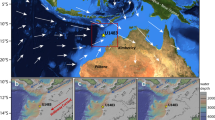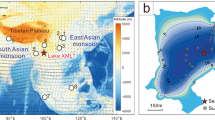Abstract
The hydroclimate history of North America includes the formation and desiccation of large inland lakes and the growth and ablation of glaciers throughout the Quaternary period. At the Last Glacial Maximum, expanded pluvial lakes in the south1,2 and aridity in the northwest3 suggest that the winter westerly storm track was displaced southwards and migrated northwards as the Laurentide Ice Sheet waned4. However, lake highstands do not occur synchronously along zonal bands5, in conflict with this hypothesis. Here we compile a network of precipitation proxy reconstructions from lakes, speleothems, groundwater deposits, packrat middens and glaciers from the western and southwestern US, which we compare with an ensemble of climate simulations to identify the controls of regional hydroclimatic change. The proxy records suggest a precipitation dipole during the Last Glacial Maximum, with wetter than modern conditions in the southwest and drier conditions near the ice sheet, and a northwest–southeast trending transition zone across the northern Great Basin. The models that simulate a weaker and south-shifted Aleutian low-pressure system, a strong North Pacific high-pressure system, and a high above the ice sheet best reproduce this regional variation. We therefore conclude that rather than a uniformly south-shifted storm track, a stronger jet that is squeezed and steered across the continent by high-pressure systems best explains the observed regional hydroclimate patterns of the Last Glacial Maximum.
This is a preview of subscription content, access via your institution
Access options
Subscribe to this journal
Receive 12 print issues and online access
$259.00 per year
only $21.58 per issue
Buy this article
- Purchase on Springer Link
- Instant access to full article PDF
Prices may be subject to local taxes which are calculated during checkout



Similar content being viewed by others
References
Reheis, M. C. et al. Pluvial lakes in the Great Basin of the western United States—a view from the outcrop. Quat. Sci. Rev. 97, 1–25 (2014).
Ibarra, D. E. et al. Rise and fall of late Pleistocene pluvial lakes in response to reduced evaporation and precipitation: Evidence from Lake Surprise, California. Geol. Soc. Am. Bull. 11–12, 1387–1415 (2014).
Whitlock, C. & Bartlein, P. J. Vegetation and climate change in northwest America during the past 125 kyr. Nature 388, 57–61 (1997).
Hostetler, S. & Benson, L. V. Paleoclimatic implications of the high stand of Lake Lahontan derived from models of evaporation and lake level. Clim. Dynam. 4, 207–217 (1990).
Lyle, M. et al. Out of the tropics: The Pacific, Great Basin Lakes, and Late Pleistocene water cycle in the western United States. Science 337, 1629–1633 (2012).
Lu, J., Vecchi, G. A. & Reichler, T. Expansion of the Hadley cell under global warming. Geophys. Res. Lett. 34, L06805 (2007).
Scheff, J. & Frierson, D. M. W. Robust future precipitation declines in CMIP5 largely reflect the poleward expansion of model subtropical dry zones. Geophys. Res. Lett. 39, L18704 (2012).
Seager, R. & Vecchi, G. A. Greenhouse warming and the 21st century hydroclimate of southwestern North America. Proc. Natl Acad. Sci. USA 107, 21277–21282 (2010).
Ulbrich, U. et al. Changing northern hemisphere storm tracks in an ensemble of IPCC climate change simulations. J. Clim. 21, 1669–1679 (2008).
IPCC Climate Change 2013: The Physical Science Basis (eds Stocker, T. F. et al.) (Cambridge Univ. Press, 2013).
DiNezio, P. N. & Tierney, J. E. The effect of sea level on glacial Indo-Pacific climate. Nature Geosci. 6, 485–491 (2013).
COHMAP Members, Climatic changes of the last 18,000 years—observations and model simulations. Science 241, 1043–1052 (1988).
Bromwich, D. H. et al. Polar MM5 simulations of the winter climate of the Laurentide Ice Sheet at the LGM. J. Clim. 17, 3415–3433 (2004).
Kim, S-J. et al. High-resolution climate simulation of the last glacial maximum. Clim. Dynam. 31, 1–16 (2008).
Unterman, M. B. et al. Paleometeorology: High resolution Northern Hemisphere wintertime mid-latitude dynamics during the Last Glacial Maximum. Geophys. Res. Lett. 38, L23702 (2011).
Braconnot, P. et al. Results of PMIP2 coupled simulations of the Mid-Holocene and Last Glacial Maximum—Part 1: Experiments and large-scale features. Clim. Past 3, 261–277 (2007).
Braconnot, P. et al. Evaluation of climate models using palaeoclimatic data. Nature Clim. Change 2, 417–424 (2012).
Cohen, J. Weighted kappa: Nominal scale agreement with provision for scaled disagreement or partial credit. Psychol. Bull. 70, 213–220 (1968).
Wise, E. K. Spatiotemporal variability of the precipitation dipole transition zone in the western United States. Geophys. Res. Lett. 37, L07706 (2010).
Laabs, B. J. C., Plummer, M. A. & Mickelson, D. M. Climate during the last glacial maximum in the Wasatch and southern Uinta Mountains inferred from glacier modeling. Geomorphology 75, 300–317 (2006).
Locke, W. W. Late Pleistocene glaciers and the climate of western Montana, U. S. A. Arct. Alp. Res. 22, 1–13 (1990).
Kageyama, M. et al. Mid-Holocene and Last Glacial Maximum climate simulations with the IPSL model—part 1: Comparing IPSL_CM5A to IPSL_CM4. Clim. Dynam. 40, 2447–2468 (2013).
Hostetler, S. W. et al. Lake–atmosphere feedbacks associated with paleolakes Bonneville and Lahontan. Science 263, 665–668 (1994).
Maher, K. et al. Uranium isotopes in soils as a proxy for past infiltration and precipitation across the western United States. Am. J. Sci. 314, 821–857 (2014).
Winnick, M. J. et al. Quantifying the isotopic ‘continental effect’. Earth Planet Sci. Lett. 406, 123–133 (2014).
Lawrence, D. M. et al. The partitioning of evapotranspiration into transpiration, soil evaporation, and canopy evaporation in a GCM: Impacts on land–atmosphere interaction. J. Hydrometeorol. 8, 862–880 (2007).
Caballero, R. & Hanley, J. Midlatitude eddies, storm-track diffusivity, and poleward moisture transport in warm climates. J. Atmos. Sci. 69, 3237–3250 (2012).
Chavaillaz, Y., Codron, F. & Kageyama, M. Southern westerlies in LGM and future (RCP4.5) climates. Clim. Past 9, 517–524 (2013).
Bartoń, K. MuMIn: Multi-Model Inference, R Package (R Foundation for Statistical Computing, 2014); http://cran.r-project.org/web/packages/MuMIn/MuMIn.pdf
Duchon, C. E. Lanczos filtering in one and two dimensions. J. Appl. Meteorol. 18, 1016–1022 (1979).
Acknowledgements
We appreciate constructive comments from N. Diffenbaugh and D. Horton. We gratefully acknowledge the international climate modelling groups participating in PMIP2 and CMIP5/PMIP3 for producing and making their model output available for analysis, and the PMIP2 Data Archive (supported by CEA, CNRS, and PNEDC) and PCMDI (supported by the US Department of Energy) for distributing the data. PMIP databases were last accessed in September 2014. D.E.I. and M.J.W. acknowledge support from C. P. Chamberlain. This work was supported by the National Science Foundation grants to J.L.O. (AGS1203701) and K.M. (EAR0921134).
Author information
Authors and Affiliations
Contributions
D.E.I. and J.L.O. conceived the project, compiled the proxy data, and conducted the statistical analyses. D.E.I. and M.J.W. analysed the model output. J.L.O. and D.E.I. synthesized the results and wrote the manuscript with contributions from all authors.
Corresponding author
Ethics declarations
Competing interests
The authors declare no competing financial interests.
Supplementary information
Supplementary Information
Supplementary Information (PDF 21974 kb)
Supplementary Information
Supplementary Information (XLSX 51 kb)
Supplementary Information
Supplementary Information (XLSX 32 kb)
Supplementary Information
Supplementary Information (XLSX 48 kb)
Supplementary Information
Supplementary Information (XLSX 51 kb)
Supplementary Information
Supplementary Information (XLSX 45 kb)
Supplementary Information
Supplementary Information (XLSX 61 kb)
Supplementary Information
Supplementary Information (XLSX 59 kb)
Supplementary Information
Supplementary Information (XLSX 55 kb)
Supplementary Information
Supplementary Information (XLSX 49 kb)
Rights and permissions
About this article
Cite this article
Oster, J., Ibarra, D., Winnick, M. et al. Steering of westerly storms over western North America at the Last Glacial Maximum. Nature Geosci 8, 201–205 (2015). https://doi.org/10.1038/ngeo2365
Received:
Accepted:
Published:
Issue Date:
DOI: https://doi.org/10.1038/ngeo2365
This article is cited by
-
A 350,000-year history of groundwater recharge in the southern Great Basin, USA
Communications Earth & Environment (2023)
-
Impacts of the PMIP4 ice sheets on Northern Hemisphere climate during the last glacial period
Climate Dynamics (2023)
-
Three modes of climate change since the Last Glacial Maximum in arid and semi-arid regions of the Asian continent
Journal of Geographical Sciences (2022)
-
Great Plains storm intensity since the last glacial controlled by spring surface warming
Nature Geoscience (2021)
-
Late Pliocene to early Pleistocene climate dynamics in western North America based on a new pollen record from paleo-Lake Idaho
Palaeobiodiversity and Palaeoenvironments (2021)



